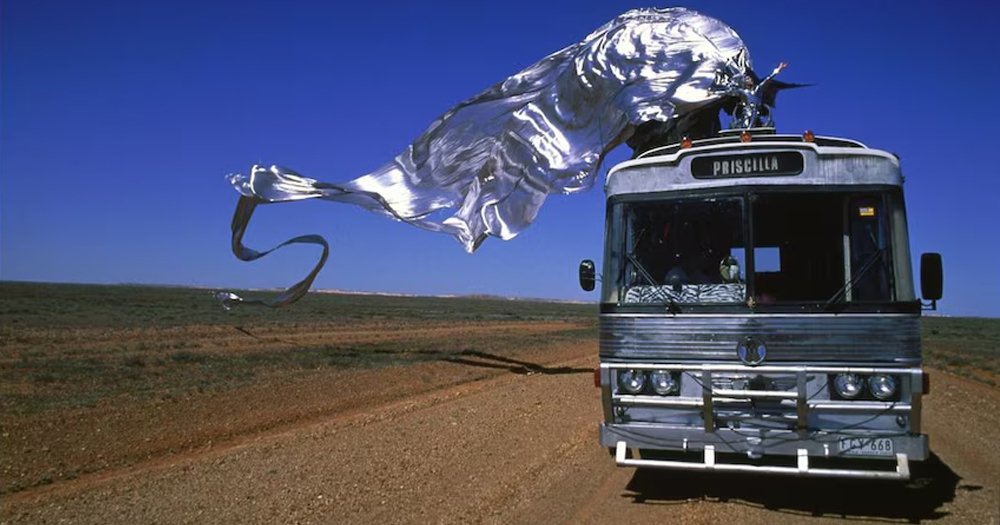The legendary bus featured in queer classic Priscilla, Queen of the Desert has been found after 30 years and is now undergoing restoration to be displayed in a museum.
Thirty years ago, a 1976 Japanese model bus was transformed into a piece of cinematic history when the low-budget Australian film Priscilla, Queen of the Desert became an Oscar-winning success and beloved queer classic. What some might not know is that, not long after the shoot for the film ended in 1993, the silver bus vanished without a trace.
The disappearance of the Priscilla, Queen of the Desert bus prompted countless Australians to claim they owned it or had spotted it around the country. For almost 25 years, the History Trust of South Australia searched for the bus in vain, hoping to acquire it for the National Motor Museum in Birdwood, SA, where several iconic cars from cinema are already on display.
For this reason, when a man contacted the History Trust in 2019, saying that Priscilla was sitting on his property, the staff were initially quite sceptical. Head of museums at the History Trust, Paul Rees, explained how when they first got the call, they “were a bit suspicious at first, to be honest. But we put our Sherlock Holmes hats on and soon realised it wasn’t a joke, so we started our investigation.”
What they uncovered was that the Priscilla, Queen of the Desert bus belonged to a couple who eventually split up. One of them took the bus to their new partner’s property around 2006, where it was abandoned when that relationship also ended. When the owner of the property in Ewingar passed away, the house was sold to a man named Michael Mahon.
#DidYouKnow ?
In “The Adventures of Priscilla, Queen of the Desert” (1994), the silver tour bus used in the film broke down during production. This unexpected event led to a hilarious scene with Aboriginal #Australians, adding an authentic and memorable moment to the film. ??✨ pic.twitter.com/4fyjzrseie— S.D. Reyes (@SantiagoDiazre4) June 20, 2023
After acquiring the property and discovering the bus, Mahon did some research on its provenance and started making phone calls, including the one directed to the History Trust.
“Talking to people in the bus industry, they just said ‘Priscilla? That’s the hunt for Red October, they’ve been looking for it for years’,” Mahon said, recounting how he looked into the history of the bus. “They’ve been calling it the holy grail and I said ‘well, it’s at my place’. Everyone just didn’t believe me.”
Mahon explained that he thought the bus belonged in a museum because, just like the film, it was “iconic before its time.” He added, “I can see a piece of Australian history is going to be saved, and it will belong to all Australians.”
Now the Priscilla, Queen of the Desert bus is finally undergoing restoration, which is expected to take $750,000 and up to 18 months. A campaign has been launched to fund the restoration, with the South Australian government providing $100,000. After the process is completed, the iconic bus will be displayed at the National Motor Museum at Birdwood in the Adelaide Hills.
Speaking to ABC Radio Adelaide, History Trust chief executive officer Greg Mackie said “We want to create a bespoke, unique, world standard visitor attraction of Priscilla in an interpretive presentation with screens and moving images.”
Priscilla, Queen of the Desert bus was thought to be lost until it was discovered on property in New South Wales in 2019. Once it’s fully restored, Priscilla will go on display at the National Motor Museum at Birdwood in the Adelaide Hills. https://t.co/rpv6tXf8d4 pic.twitter.com/pfqFivu4aR
— Ben John (@benjohn65) April 12, 2024
“As a gay man who was coming into my identity through the HIV-AIDS crisis of the 1980s and early 1990s, the advent of The Adventures of Priscilla, Queen of the Desert absolutely transformed my sense of my place in the world,” Mackie said.
“I know that has been repeated millions of times around the world. It’s not only about drag queens, it’s actually about the common humanity of every single one of us – that’s what gave Priscilla its potent power.”
The film’s director Stephan Elliott, who has recently announced a sequel for the iconic queer classic, said he was consulted throughout the project to bring the bus back to its former glory.
“We had heard so many rumours about where she had ended up and had given up hope of finding her again,” Elliott said. “But when they [SA History Trust] showed me the photographs, I knew immediately just by looking at the bumper at the front and the carpet inside that we had found it.
“The film seems to carry through generations, and this is a chance for possibly many more generations to feel its message of love, tolerance and living your true self every day.”
© 2024 GCN (Gay Community News). All rights reserved.
Support GCN
GCN is a free, vital resource for Ireland’s LGBTQ+ community since 1988.
GCN is a trading name of National LGBT Federation CLG, a registered charity - Charity Number: 20034580.
GCN relies on the generous support of the community and allies to sustain the crucial work that we do. Producing GCN is costly, and, in an industry which has been hugely impacted by rising costs, we need your support to help sustain and grow this vital resource.
Supporting GCN for as little as €1.99 per month will help us continue our work as Ireland’s free, independent LGBTQ+ media.

comments. Please sign in to comment.